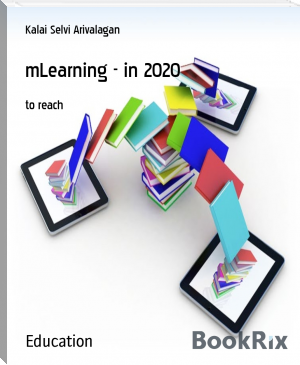INNOVATIONS IN SCIENCE, TECHNOLOGY AND MATHEMATICS EDUCATION IN NIGERIA, Ebele C. Okigbo, Nneka R. Nnorom, Ernest O. Onwukwe [best reads .TXT] 📗

- Author: Ebele C. Okigbo, Nneka R. Nnorom, Ernest O. Onwukwe
Book online «INNOVATIONS IN SCIENCE, TECHNOLOGY AND MATHEMATICS EDUCATION IN NIGERIA, Ebele C. Okigbo, Nneka R. Nnorom, Ernest O. Onwukwe [best reads .TXT] 📗». Author Ebele C. Okigbo, Nneka R. Nnorom, Ernest O. Onwukwe
Keywords: Project Instructional Strategy, Chemistry, Achievement, Retention.
Introduction
Chemistry is the branch of science concerned with the study of matter, its properties and uses. Chemistry has contributed immensely towards providing man’s basic needs and improving the quality of life. For instance, the manufacture of fertilizer and pesticides has improved food production. To a large extent, the services of chemists are essential in the quality control of drugs manufactured in industries as a way of controlling adulteration of drugs in Nigeria (Njelita 2005). Again scientific and technological fields such as medicine, biochemistry, engineering, microbiology and so on have chemistry built in them (Attah & Njoku, 2018). This shows that chemistry is everywhere; chemistry is life, the oracle and crown prince of modern science (Oloyede, 2012, Opara and Waswa, 2013).
Despite the key role of chemistry as the central science that form the basic foundation of many disciplines and in improving the quality of our life, the performance of Nigerian secondary school students in the subject has for many years remained a matter of serious concern (Jegede, 2010 and Oloyede, 2012). Effort made through research to discover the causes of persistent failure in the subject revealed that the weaknesses associated with the performances of candidates in chemistry were attributed to lack of relevant textbooks, inadequate preparation for examination and non familiarization with examination syllabus, which was in essence attributed to the wrong teaching method or instructional strategy teachers are using in the teaching of chemistry; that the teaching does not stimulate learning (Njoku, 2012).
The way students learn is as important as what they learn. According to Egolum and Igboanugo (2017) identified teachers methodologies and teaching strategies as factors causing mass failure of students in secondary school sciences in general and chemistry in particular. Chemistry classroom presently is described as inappropriate and uninspiring. Again, for learning to be meaningful and effective in chemistry classroom, the teacher should be able to select appropriate teaching strategies and approaches that will be able to stimulate the interest of the learners and get them actively engaged in the process of learning.
Many active learning instructional strategies such as brain-stoming , process-based approach, role-playing, field trip, demonstration, problem solving, think-pair-share have been identified as effective in chemistry teaching (Egolum & Njelita, 2015). The researchers therefore intend to identify the effect of project instructional strategy on chemistry students academic achievement and retention.
Project instructional strategy could be in form of individualized instruction whereby the learner performs a unit of work in a natural manner. Individual students or groups of student may work on a given task to arrive at a common goal under the guidance or supervision of the teacher. The project topic is chosen on the basis of the background, experience or interest of the students and the work should be an original work, honestly performed by the students (Okoye 2014). Project method provides an excellent opportunity for the complete act of thinking by the students during which students can define the problem, plan their work, find appropriate resources, carryout their plans and draw conclusion (Uduchukwu 2016). Hence project work encourages creativity, originality, promotes individualized learning collaboration amongst students and builds self-confidence in the learners.
Again, with projects, students use higher order thinking skills rather than memorizing facts in an isolated context without a connection to how and where they are used in the real world. Project strategy allows students to bounce ideas of each other, voice their opinion, and negotiate solutions and skills that will be necessary in the work place. It enables students take pride in accomplishing something that has value outside the classroom and also allow them to use their individual strength and diverse approaches of learning (Thomas, 2013). After the projects, chemistry students are assessed to determine their achievements. Achievement in science generally is an important variable that expresses the success or failure in a teaching/learning process. Achievement is referred to as scholastic standing of a learner at a given moment which can be measured by grades obtained from examination or assessment. Achievement has also been described by Aniekwe (2016) as something which has been accomplished successfully especially by means of exertion, skills, practice or perservance. Academic achievement therefore could be referred to as the degree of success reached or attained by an individual in some general or specific academic area which is measurable. Students, teacher, parents and society at large are concerned about academic purpose.
Retention is the ability of keeping something in one's memory. It is the ability to possess, use or keep information and ability to reproduce past experiences or previously familiar materials. Retention according to Ngwoke & Eze (2016) is the process by which a learner stores information in his memory for use at a latter period. Retention occurs when facts or experience are stored in the long term memory. A student may be able to memorize facts in the short term, but may not retain those facts over the long term memory.
Purpose of the Study
The purpose of the study was to determine the effect of project instructional strategy on chemistry student’s achievement and retention. Specifically, the study sought to:
Determine the effect of project instructional strategy on chemistry students’ achievements.
Determine the effect of project instructional strategy on chemistry students’ retention.
Research Questions
The following research questions guided the study;
What are the mean achievement scores of secondary school students taught chemistry using project instructional strategy and those taught using conventional (lecture) method?
What are the mean retention scores of secondary school students taught chemistry using project instructional strategy and those taught using conventional (lecture) method?
Research Hypotheses
The following research hypothesis guided the study at 0.05 level of significance.
There is no significant difference in the mean achievement scores of chemistry students taught through the project strategy and those taught using conventional (lecture) method.
There is no significant difference in the mean retention scores of chemistry students taught through the project strategy and those taught using conventional (lecture) method.
Problem of the Study
Studies have shown that some teachers still use didactic (lecture) approach which does not make room for effective learning as well as retain that which is learnt. Again, some other researchers have cited that there are active learning instructional strategy which enhance learning such as use of projects as instructional strategy but there is no empirical work known to the researchers on that. The present study intends to identify the effect of project instructional strategy on students’ academic achievement and retention.
Method
Design of the Study
Quasi-experimental research design involving pre-test, post-test, non-equivalent control group design was used.
Area of the Study
This study was carried out in secondary schools in Oyi Local Government Area of Anambra State.
Population of the Study
The target population of the study consists of all the Senior Secondary II (SS2) chemistry students in Oyi Local Government Area of Anambra State. There are eleven (11) government owned secondary schools in Oyi Local Government Area. The total number of students in the population of those offering chemistry were six hundred and fifty- six (656) students.
Sample and Sampling Techniques
Simple random sampling technique was used to select four (4) coeducational schools with intact classes out of the eleven (11) government owned secondary schools in the local government area. Two schools were assigned experimental group while the other two schools were used as control group. A total of one hundred and fifty (150) students were selected for the study. The sample for the experimental groups was made up of eighty-two (82) students.
Instrument for Data Collection
One instrument was used for this study; the instrument was the Chemistry Project Achievement Test (CPAT) which serves as both achievement and retention tests. The CPAT consists of 20 multiple choice items carefully drawn from past WAEC question papers (2009-2001).
Validity of the Instrument
Before administering the test, the CPAT was subjected to content and face validity by giving the CPAT to two lecturers in chemistry department and two lecturers in measurement and evaluation department all of Nwafor Orizu College of Education, Nsugbe. These experts validated the items in terms of clarity of language, appropriateness and adequacy of the items in measuring what they are supposed to measure. The six lesson plans based on periodic table and families of element (three constructed using project instructional strategy and the other three using the lecture method) were also validated by these experts.
Reliability of the instrument
To ensure the reliability of the instrument; the CPAT was administered to the group of twenty (20) SS II chemistry students who were not among those sampled for the study and the data obtained from the response of the students were used to estimate the reliability of the instrument. The reliability of the CPAT was determined using Cronbach alpha. The result showed reliability co-efficient of 0.79. This value is high indicating that the instrument is reliable.
Experimental Procedure/ Administration of the Instrument
The experimental and control group were taught by two researchers. The lesson lasted for 3 weeks i.e. the researchers used 2 periods (80 minute) each week to teach the lessons. The researchers also gave students in the experimental group project on periodic table and families of periodic table. The pre-test was administered to the students before the treatment to measure the extent they have known the topic to be taught and provide the researchers with baseline data about the subject. Post-test was administered to the students after the treatment while retention test was administered two weeks after the post-test the experiment and administration of the instruments lasted for six (6) weeks.
Method of Data Analysis
The researchers employed the use of mean and standard deviation to answer the research questions, while t - tests was used to test the hypotheses at 0.05 level of significance.
Results of the Study
Research question one: What are the mean achievement scores of secondary school students taught chemistry using project instructional strategy and those taught using conventional (lecture) method.
Table 1: Mean achievement scores and standard deviation on post-test scores of students taught chemistry using project instructional strategy and those taught using conventional (lecture) method
Sources of Variation N
df
Mean Std.dev
Mean. Gain
Project Instructional Strategy 82
(Experimental group)
Lecture Method 68
(Control group)
148
66.48 17.77
47.41 13.41
31.89
12.92
Results in Table 1 show that the experimental group taught chemistry using project instructional strategy had a post- test mean score of 66.48 and a standard deviation of 17.77 with a mean gain of 31.89; while the control group had the post-test mean scores of 47.41 and a standard deviation of 31.41 with a mean gain of 12.92. This result confirms that students taught chemistry using project instructional strategy had a higher mean score than those taught with conventional (lecture) method.
Research question two: What are the mean retention scores of secondary school students taught chemistry using project instructional strategy and those taught using conventional (lecture) method.
Table 2: Mean retention scores and standard deviation of students taught chemistry using project instructional strategy and those taught using conventional (lecture) method.
Sources of Variation
N
Df
Mean
std.dev
Project Instructional Strategy
(Experimental group)
Lecture Method
(Control group)
82
68
148
66.17
46.90
17.47
13.31
Results in Table 2 show that the experimental group taught chemistry using project instructional strategy had a mean score of 66.17 and a standard deviation of 17.47; while the control group had mean scores of 46.90 with a standard deviation of 13.31. This result confirms that students taught chemistry using project instructional strategy had a higher mean score than





Comments (0)